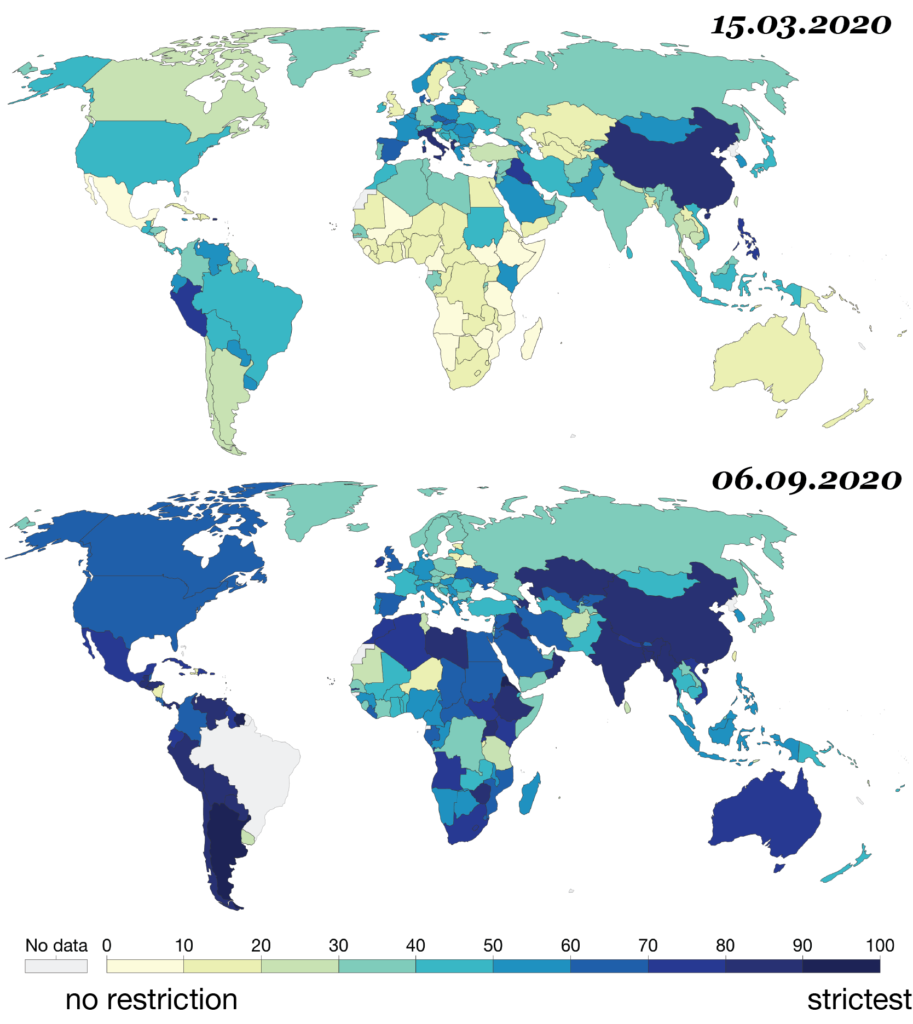Several countries have received praises for their timely responses that helped curb the spread of COVID-19. Very different countries made the list, including Taiwan, Singapore, South Korea, Australia, New Zealand, Canada, Germany, Iceland, the U.A.E, Greece, and Argentina1. On the other hand, among countries with similar size and wealth, the pandemic is leaving a more severe mark on some as compared to others. Figuring out precisely what each country is doing right by direct comparison is extremely challenging. This stems from the complex interactions among many factors, such as policies, political agendas, social behaviors, and cultural values, to name a few. Which governmental responses are effective? Which ones worsen the suffering? The answers to these questions are important. They will not only help the world develop better policies and measures to fight COVID-19 but also prepare us for a better response in the future.
Why is directly comparing countries so difficult? Let us look at this example of hospital resources in the U.S. in the context of its preparedness for COVID-192. In comparison to countries with similar wealth, the U.S. has fewer physicians and hospitals per capita and hospital beds per person. By looking only at these factors, it is easy to conclude that they contribute to the seemingly untamable outbreak. However, the U.S. also has more nurses per capita and more hospital CT scanners, which should, in theory, help alleviate COVID-19.
In reality, separating one dimension that affects the pandemic from another in research is close to impossible. For example, the U.S. is an outlier among similar countries in its health insurance coverage. American adults pay more out-of-pocket medical expenses and tend to delay or forego medical care when they cannot afford it2. Although the U.S. has a smaller elderly population who are at a high risk for COVID-19-related illness, American adults are more likely to die from conditions linked to severe complications of COVID-19, including cardiovascular diseases, respiratory diseases, and diabetes2. An informative analysis, therefore, factors in just one or a few specific dimensions of the pandemic at a time using indicators that researchers agree upon based on prior scientific research and unbiasedly collected data.
This is precisely what a research team at Oxford University did to establish the Oxford COVID-19 Government Response Tracker (OxCGRT), which was announced in April. The first tool of its kind, OxCGRT is the result of an ongoing collation project that gathers live data daily since January. It systematically tracks the global governmental responses to COVID-19 and has so far collected data from more than 180 countries on 17 common policy indicators—such as school closures and travel restrictions. OxCGRT describes four indices to measure the governmental responses: the Government Stringency Index, the Overall Government Response Index, the Containment and Health Index, and the Economic Support Index. Each index represents a key dimension of the pandemic3. This database has become not only the basis for further studies but also a convenient source for anyone who is curious about how each country is performing. For visualization, the country-by-country—and the American state-by-state—results can be easily compared in the interactive mode on OxCGRT. While deciphering the large amount of information takes time, some patterns started to emerge in studies that used the OxCGRT data to answer a fundamental question: which government takes which measures and when. For example, fewer hospital beds is associated with a more stringent governmental response4, which might explain the correlation between developing countries and their stricter measures.
Many other teams joined forces to gather data on governmental interventions. This includes researchers at the Complexity Science Hub Vienna (CSH Vienna)5 and public health organizations and non-profit organizations, such as the Assessment Capacities Project (ACAPS)6, which analyzes humanitarian crises. The accumulated data are a mountain of hidden treasures that can be mined carefully to find answers to difficult questions. For example, CSH Vienna studies patterns in governmental responses by grouping countries based on when in the epidemics the interventions began and the number of restrictions introduced. In the early stages, Sweden, the U.K., and the Netherlands implemented few measures of mandatory compliances compared to other similar countries. Later, the U.K. and the Netherlands adopted more aggressive responses (e.g. country-wide lockdown)7.
Research on governmental responses teaches us valuable lessons. For example, poorer nations appeared to adopt stricter measures faster than the wealthier ones. Haiti enforced lockdown after confirming its first case6. However, the reason is not clear—it could be the increased national cautiousness due to less-developed health-care systems4. Or, the outbreak might have reached these countries later, giving them time to learn from others. Yet another likely explanation is that the experience dealing with previous outbreaks, such as Ebola and AIDS in Africa8, prepared these nations for COVID-19. By testing possible explanations, policy-makers and researchers can act upon new findings. Collection, analysis, and visualization of the pandemic data will also give the general public a simple way to engage by understanding how to stay safe and influence polices by voting.
Sources and Further Reading
- Bremmer, Ian. “The Best Global Responses to COVID-19 Pandemic.” Time, 12 June 2020, time.com/5851633/best-global-responses-covid-19.
- “How Prepared Is the US to Respond to COVID-19 Relative to Other Countries?” Peterson-KFF Health System Tracker, 15 Apr. 2020, www.healthsystemtracker.org/chart-collection/how-prepared-is-the-us-to-respond-to-covid-19-relative-to-other-countries/#item-start.
- “Coronavirus Government Response Tracker.” Blavatnik School of Government, 18 Mar. 2020, www.bsg.ox.ac.uk/research/research-projects/coronavirus-government-response-tracker.
- Gustafsson, Martin. “How Does South Africa’s Covid-19 Response Compare Globally? A Preliminary Analysis Using the New OxCGRT Dataset.” Working Papers, July 2020, ideas.repec.org/p/sza/wpaper/wpapers342.html.
- “CSH COVID19 Info Point.” CSH Vienna, www.csh.ac.at/covid19. Accessed 31 Aug. 2020.
- “ACAPS.” ACAPS, www.acaps.org. Accessed 31 Aug. 2020.
- Gibney, Elizabeth. “Whose Coronavirus Strategy Worked Best? Scientists Hunt Most Effective Policies.” Nature, 27 Apr. 2020, www.nature.com/articles/d41586-020-01248-1?error=cookies_not_supported&code=c33a808d-7440-49e6-98de-2196f33fe78c.
- “Policy Brief: Impact of COVID-19 in Africa, 20 May 2020 – World.” ReliefWeb, 21 May 2020, reliefweb.int/report/world/policy-brief-impact-covid-19-africa-20-may-2020.
